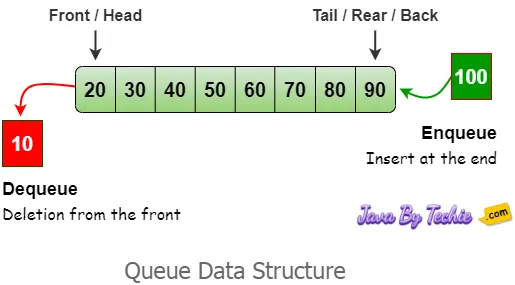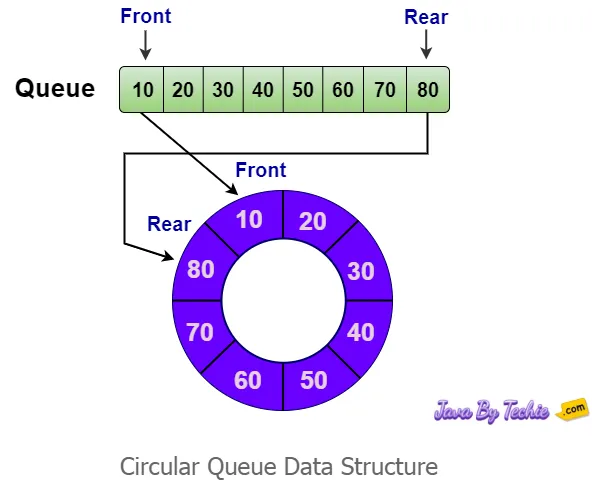

Last Updated: 16 November, 2024 4 Mins Read
In computer science, Queues are fundamental data structures that follow the FIFO (First In First Out) principle, which means the first element inserted in the queue is the first one to be removed from the queue.
In this article, we'll learn about a Linear Queue and Circular Queue in data structure, focusing on the advantages of using a Circular Queue over a Linear Queue.
A Queue is a linear data structure to store and manipulate the data elements. The queue data structure apply the concept of "First in, First out" (FIFO), which means the first added element into the queue to be the first removed from the queue. Queues do not allow random insertion and deletion operations.
A Queue is open at both ends, which enables insert operations to be performed at one end called REAR or TAIL and delete operations to be performed at another end called FRONT or HEAD.

A Circular Queue is another type of queue; it also follows the principle of First in, First out" (FIFO). In the circular queue, the last element is connected to the first element of the queue, forming a circle.
A circular queue solves the major limitation of a normal queue. In a normal queue, once a queue is full, we cannot insert a new element, even if there is a space in front of the queue.
A circular queue allows us to keep on inserting an element; if it reaches the end of the queue, then again insert from the start. Such types of queues are very efficient and useful for tasks like buffering data in a computer system, managing waiting lists, and making sure no memory space is wasted.
Circular queue is also called Ring Buffer.

A circular queue solves the following limitation of the linear queue:
Flexible insertion and deletion operation: A linear queue does not allow us to add more elements once the rear end points to the last index, but in a circular queue, elements can be added till the queue isn't full.
Operation simplicity: In the linear queue, the element inserted first is the element to be deleted first, but the circular queue does not do the same because its front and rear are not fixed. A circular queue allows us to modify the order of insertion and deletion, which makes it highly beneficial.
Memory efficiency: As compared to a linear queue, a circular queue is more efficient because it allows us to add elements until it is full. As a result, no further space is available. In a linear queue, the empty space left after dequeue operations can never be filled.
Improved Performance: Circular queues offer better performance for enqueue and dequeue operations since they avoid the need to shift elements during dequeuing.
That's all, guys. I hope this article is helpful for you.
Happy Learning... 😀
feedback@javabytechie.com